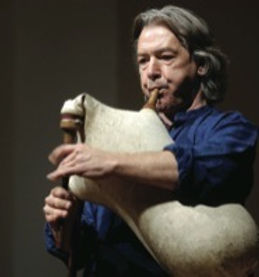
DIRK CAMPBELL
Composer and ethnic instrument
specialist
Click on a picture below for instrumental performances and information. Each picture takes you through to a class of instrument which I have played in film, TV and album recordings and in concert, and you can listen to the sounds.
PERFORMANCE CREDITS:
FILMS INCLUDE
Aladdin
The Mummy
Harry Potter and the Goblet of Fire
TV INCLUDES
The State
Indian Summers
The Virgin Queen
THEATRE INCLUDES
Hamlet (RSC)
Julius Caesar (RSC)
Morte d'Arthur (RSC)

FAQ: Why do Arabs play Scottish Highland pipes? Answer: for the same reason that locals everywhere in the former British Empire play them; the Scottish regiments with their marching music made an indelible impression on the natives, the warlike sound of the Highland pipes in many cases similar to their own double-reeded pipe, they adopted the Scottish instrument for themselves.

Bagpipes
Italian zampogna
Balkan gaida
The world's most evolved bagpipes, the Irish uilleann pipes, are bellows blown with seven or eight separate pipes: chanter, three drones and three or four regulators or
pipes. The chanter has an
range of nearly two octaves and may be fitted with keys making
it fully chromatic.
The zampogna is from southern Italy and Sicily. The world's only extant polyphonic bagpipe (apart from its single-reeded variant surdulina), it has two chanters, one for each hand. The drone pipe is pitched on the fifth of the scale, midway between treble and bass chanters. It can be operated by the thumb to produce two or more notes to create three-part harmony in combination with the two chanters.
The gaida or gajda is from Macedonia, Thrace and Epirus, areas which form part of Greece, Bulgaria, former Yugoslavia and Albania. It has a single reeded chanter and one drone. The chanter features a small upper finger hole which allows a modified chromaticism by raising the pitch of certain lower notes by a semitone. The bag is traditionally made from the whole skin of a goat.
accompanying
effective
Greek gaida





The tulum is from the Greek area of northern Turkey known as Pontos. This droneless proto-bagpipe is found in various forms everywhere from Algeria to Afghanistan. The sound is identical to that of the mijwiz (see reeded pipes on this site) though the playing style varies - compare tulum and mezoued performances, above right (mp3s).The photo shows me doing the Pontic lying-on-the-floor-while-playing-the-tulum trick at a performance with the Lyra Dancers, London 2012
Medieval depictions of bagpipers. The bagpipe exists in various forms as a national instrument in every country in Europe and in many countries of the middle East and central Asia.
Czech dudy
Breton veuze
Scottish regimental piper, WWI
Saudi Arab playing Scottish Highland pipes
Gulf Arab playing indigenous habban
North African mezoued


All performances/arrangements by Dirk Campbell. See foot of page for details of tunes
Pontic tulum
Breton veuze, Czech dudy, Italian zampogna
Czech dudy, Italian surdulina, Greek laouto
Tune names and performance details
Uilleann pipes: jig set 'The Girl in the Big House/Paddy O Rafferty' (traditional); reel set 'The Old Bush/An Bhean Tinceara' (traditional); slow air 'Cití na gCumann' (traditional, string arrangement by Dirk Campbell); Gaida: 'Simera eíne Kyriakí' (traditional Greek zonaradiko, with toumbeleki); Zampogna: 'Minuetto' (Wilton)/'Canario' (von der Hofe); Tulum: 'Tik' (traditional Greek Pontic dance); Mezoued: 'Chaabi' (Campbell, with frame drums); Highland pipes: reel 'The Old Man of Glengarry' (traditional); Veuze: 'Stones of Plouhinec' (Campbell, with dudy and zampogna); Dudy: 'Do Your Dudy' (Campbell, with laouto and surdulina)


